CHAPTER SIX Part TWO
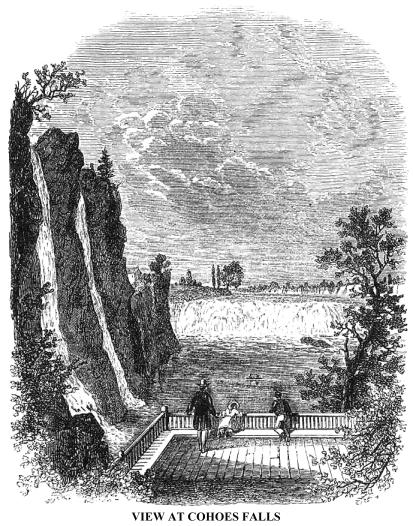
The width of the grand cataract of Cohoes is nine hundred feet, and the fall seventy-eight feet, of which about forty are perpendicular. Below the fall, the water rushes over a rocky bed, in foaming rapids, between high banks, to the plain, where the islands divide it into channels, and through these it flows gently into the Hudson. It was a beautiful afternoon in early spring when we visited the falls. The water was abundant, for the snow upon the hills that border the charming valley of the Mohawk was rapidly melting, and filled the river to the brim. We never saw the cataract in more attractive form, and left it with reluctance when the declining sun admonished us to ride back to Waterford, for we intended to cross the long bridge there, pass through Lansingburgh, and lodge that night in Troy. It was just at sunset when we crossed the bridge and entered the beautiful avenue which leads through Lansingburgh, into the heart of Troy. Through the village it is shaded with stately elms, and along the whole distance of two miles between that "New City" of the past and modern Troas, it follows the bank of the river in a straight line, and affords a most delightful drive in summer.
In the upper suburb of Troy we came to a mass of rock rising a few yards from the avenue to the height of fifty or sixty feet, with a tall, crooked sapling shooting up from its summit, which had been placed there for a flagstaff. The classical taste which gave the name of the city built where the dappled heifer of Ilus lay down, to this modern town, when it was little more than a hamlet, and which dignified the irregular hill that overlooks it with the title of Mount Ida (called Ida Hill by the inhabitants), named this rocky peak Mount Olympus. We saw nothing upon its "awful summit" to remind us of the Thessalian dwelling-place of the gods; and the apparition nearest to that of "Olympian Jove" (whom the artists portrayed in human form) that we saw in the fading twilight, was a ragged boy, with a cigar in his mouth, vainly endeavouring to climb the sapling.
The peak of Olympus was once much higher. It has been carried away from time to time to furnish materials for docks, and in strengthening the dam, twelve hundred feet in length, which the State built across the Hudson at this point to furnish a feeder to the Champlain Canal. The water at the dam has a fall of about twelve feet, and at the east end is a heavy lock, constructed of hewn stone, through which sloops and other vessels are taken into the river above, and towed by steam-tugs, us we have observed, up to Lansingburgh and Waterford. Just above the dam, and near Waterford, there is a communication between the canal and the river, and many loaded boats from the former there enter the latter, pass through the lock, and are towed, some to Troy and Albany, and others to New York. The dam also furnishes water power to a number of mills on the Troy shore below it, into which grain is taken from vessels lying at the docks, by means of "elevators" worked by the water wheels. These form a striking feature in the scene below the dam.
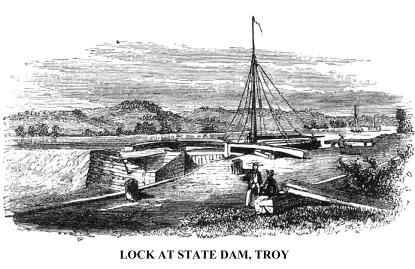 From
the lock may be obtained an excellent view of the river below, with the last
of the bridges that then spanned the Hudson. Since then a railway-bridge has
been thrown across it at Albany, six miles below. Glimpses of Troy, and Watervliet
or West Troy opposite, and of the Katzbergs, thirty miles distant, were obtained
from the same point of view. The Troy Bridge was sixteen hundred feet in length,
and connected Green Island with the main, having a draw at the eastern end
for vessels to pass through. It was used as a public highway in crossing the
river, and also as a viaduct of the Rensselaer and Saratoga Railway. It was
built of timber, was closely covered, and rested upon heavy stone piers. It
crossed where formerly lay a group of beautiful little islands, when Troy
was in its infancy. They have almost disappeared, except the larger one, which
is bisected by the bridge. Among these islands shad and sturgeon, fish that
abound in every part of the river below, were caught in large quantities,
but they are seldom seen there now.
From
the lock may be obtained an excellent view of the river below, with the last
of the bridges that then spanned the Hudson. Since then a railway-bridge has
been thrown across it at Albany, six miles below. Glimpses of Troy, and Watervliet
or West Troy opposite, and of the Katzbergs, thirty miles distant, were obtained
from the same point of view. The Troy Bridge was sixteen hundred feet in length,
and connected Green Island with the main, having a draw at the eastern end
for vessels to pass through. It was used as a public highway in crossing the
river, and also as a viaduct of the Rensselaer and Saratoga Railway. It was
built of timber, was closely covered, and rested upon heavy stone piers. It
crossed where formerly lay a group of beautiful little islands, when Troy
was in its infancy. They have almost disappeared, except the larger one, which
is bisected by the bridge. Among these islands shad and sturgeon, fish that
abound in every part of the river below, were caught in large quantities,
but they are seldom seen there now.
Troy, the capital of Rensselaer County, is six miles above Albany, at the head of tide-water, one hundred and fifty-one miles from the city of New York. It is a port of entry, and its commerce is very extensive for an inland town. It is seated upon a plain between the foot of Mount Ida and the river. It has crept up that hill in some places, but very cautiously, because the earth is unstable, and serious avalanches have from time to time occurred. Its site was originally known as Ferry Hook, then Ashley's Ferry,* and finally Vanderheyden, the name of the first proprietor of the soil on which Troy stands, after it was conveyed in fee from the Patroon of Rensslaerwyck, in the year 1720. After the Revolution the spot attracted some attention as an eligible village site. Town lots were laid out there in the summer of 1787, and two years afterward the freeholders of the embryo city, at a meeting in Albany, resolved that "in future it should be called and known by the name of Troy." At the same time, with the prescience of observing men, they said--."It may not be too sanguine to expect, at no very distant period, to see Troy as famous for her trade and navigation as many of our first towns." It was incorporated a village in 1801, and a city in 1816.
* Stephen Ashley kept the first tavern at the
ferry, in the farm-house of Matthias Vanderheyden, on the south-east corner
of River and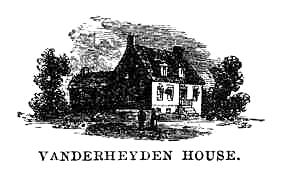 Division Streets. It is the oldest house in Troy, having been built as early
as 1752. On the front of the house, between the two windows on the left, was
a brick, on which was cut D.V.H.A.D. 1752." The initials stood for Derrick
(Richard) Vanderheyden. The D was reversed. Between the second window on the
left and the door was another brick inscribed "MVH. 1752." These
were the initials of Matthias Vanderheyden. South of the window on the right,
and a little above it, was another brick inscribed "I V H. 1752."
These were the initials of Jacob Vanderheyden. Matthias occupied this, and
the other two built houses elsewhere on the plot. Ashley afterward kept an
inn at the corner of Rover and Ferry Streets. On his sign was a portrait of
Washington, and the words, "Why here's Ashley's."
Division Streets. It is the oldest house in Troy, having been built as early
as 1752. On the front of the house, between the two windows on the left, was
a brick, on which was cut D.V.H.A.D. 1752." The initials stood for Derrick
(Richard) Vanderheyden. The D was reversed. Between the second window on the
left and the door was another brick inscribed "MVH. 1752." These
were the initials of Matthias Vanderheyden. South of the window on the right,
and a little above it, was another brick inscribed "I V H. 1752."
These were the initials of Jacob Vanderheyden. Matthias occupied this, and
the other two built houses elsewhere on the plot. Ashley afterward kept an
inn at the corner of Rover and Ferry Streets. On his sign was a portrait of
Washington, and the words, "Why here's Ashley's."
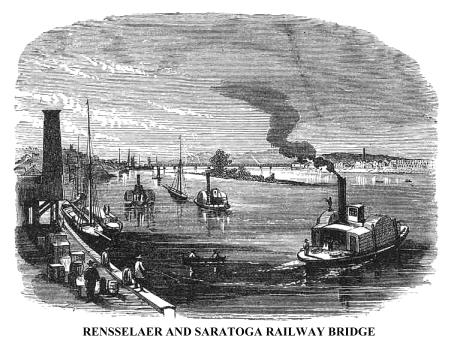 From
the beginning Troy was a rival of Lansingburgh. It was settled chiefly by
enterprising New England people. They perceived the advantages of their location
at the head of tide-water and sloop navigation, between two fine streams (Poesten
Kill and Wynant's Kill) that flow in wild cascades from Mount Ida and its
connections, affording extensive water power. After a hard struggle, Troy
was made the county-seat, and the court-house was erected there, and from
that time the growth of Lansingburgh was slow, whilst Troy increased with
wonderful rapidity. The former had 6,000 inhabitants in 1860, and the latter
almost 50,000. It has always been conspicuous for well-directed and associated
public spirit, and its institutions of learning are among the best in the
land. The most noted of these are the Rensselaer Institute, founded and endowed
by the late Stephen Van Rensselaer of the Manor, the Troy Female Seminary,
and the Troy University. The latter was established under the auspices of
the Methodist denomination, but the funds for the building were liberally
subscribed by men of various sects. It stands upon Mount Ida, and is the most
conspicuous object in a view of the city seen from any point. In its immediate
vicinity are beautiful residences, which command extensive and interesting
pictures of town and country. In their chaste and modest style of architecture,
they present striking contrasts to the more meretricious "Byzantine style"
of the University.
From
the beginning Troy was a rival of Lansingburgh. It was settled chiefly by
enterprising New England people. They perceived the advantages of their location
at the head of tide-water and sloop navigation, between two fine streams (Poesten
Kill and Wynant's Kill) that flow in wild cascades from Mount Ida and its
connections, affording extensive water power. After a hard struggle, Troy
was made the county-seat, and the court-house was erected there, and from
that time the growth of Lansingburgh was slow, whilst Troy increased with
wonderful rapidity. The former had 6,000 inhabitants in 1860, and the latter
almost 50,000. It has always been conspicuous for well-directed and associated
public spirit, and its institutions of learning are among the best in the
land. The most noted of these are the Rensselaer Institute, founded and endowed
by the late Stephen Van Rensselaer of the Manor, the Troy Female Seminary,
and the Troy University. The latter was established under the auspices of
the Methodist denomination, but the funds for the building were liberally
subscribed by men of various sects. It stands upon Mount Ida, and is the most
conspicuous object in a view of the city seen from any point. In its immediate
vicinity are beautiful residences, which command extensive and interesting
pictures of town and country. In their chaste and modest style of architecture,
they present striking contrasts to the more meretricious "Byzantine style"
of the University.
Opposite Troy is the bustling village of West Troy (formerly
Watervliet), with a population of about 9,000 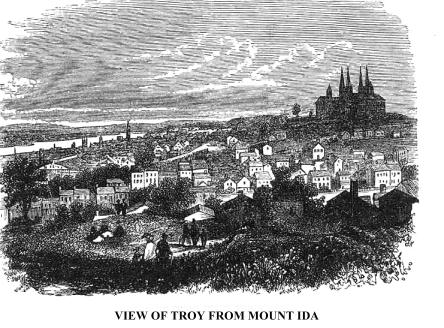 in
1860. At the south end of the village, and occupying a front of a quarter
of a mile along the west bank of the Hudson, is the United States Military
establishment called the Watervliet Arsenal. It was one of the largest of
the six principal establishments then belonging to the United States, where,
under the direction of the Ordnance Department, were manufactured the arms
and munitions of war required for the use of the army and the militia before
the Civil War. About twelve acres of land were purchased at that point by
the United States, in 1813, for arsenal purposes, and the group of buildings
seen in the sketch was erected. The grounds comprised about one hundred acres,
part covered with necessary buildings and a parade, and the remainder was
under cultivation. About two hundred yards west of the highway, the Eric Canal
passed through the grounds, and was spanned by a picturesque iron bridge near
the officers' quarters. Along the river front was a double row of stately
elm trees, whose branches form a leafy arch over the highway in summer. From
these the green-sward bank slopes gently toward the river, and affords a delightful
promenade on summer afternoons.*
in
1860. At the south end of the village, and occupying a front of a quarter
of a mile along the west bank of the Hudson, is the United States Military
establishment called the Watervliet Arsenal. It was one of the largest of
the six principal establishments then belonging to the United States, where,
under the direction of the Ordnance Department, were manufactured the arms
and munitions of war required for the use of the army and the militia before
the Civil War. About twelve acres of land were purchased at that point by
the United States, in 1813, for arsenal purposes, and the group of buildings
seen in the sketch was erected. The grounds comprised about one hundred acres,
part covered with necessary buildings and a parade, and the remainder was
under cultivation. About two hundred yards west of the highway, the Eric Canal
passed through the grounds, and was spanned by a picturesque iron bridge near
the officers' quarters. Along the river front was a double row of stately
elm trees, whose branches form a leafy arch over the highway in summer. From
these the green-sward bank slopes gently toward the river, and affords a delightful
promenade on summer afternoons.*
* I was indebted to the courtesy of Lieutenant George T. Balch, then stationed there, for the following facts:--"As the necessity for greater manufacturing facilities arose, additional lands were purchased, and extensive shops, storehouses, timer-sheds, magazines, barracks and quarters, were erected from time to time, until at the present (1860), the real estate and the improvements are valued at 500,000 dollars, and the military stores and supplies collected, in the various buildings, at 1,500,000. The principal operations carried on are the manufacture of heavy artillery carriages for the sea-coast forts, with all the requisite implements and equipments; carriages for siege trains and field batteries, with their equipments and harness; all machines used in transporting and repairing artillery; ammunition of all kinds for sea-coast, siege, and field guns, and for small arms, and the repair and preservation of the large quantity of material of war in store. The shops comprise all requisite facilities for the various mechanics employed, as well as a conveniently arranged and roomy laboratory. The motive power is water, furnished by the Erie Canal. Under ordinary circumstances from 100 to 150 workmen are employed, but, when the exigencies of the service demand it, 500 to 600 can easily be accommodated. The establishment is under the control of a field officer of the ordinance department, assisted by subalterns of the same, a military storekeeper and paymaster, who is a civilian, and the requisite master, work-men, &c. Forty enlisted Ordinance men are at present stationed at the post, who perform the necessary guard duty and drills, and are at other times variously engaged in out-of-door and mechanical employments. The United States have exclusive control of the grounds included within the arsenal enclosure, the State exercising only concurrent jurisdiction in civil actions and criminal cases."
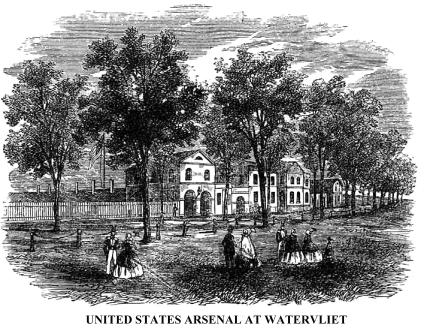 The
highway along the plain from West Albany is a fine macadamized road, with
the Erie Canal, the Hudson, and the amphitheatre of the Greenbush heights
on the left. The hills on the right are near, and pleasant mansions and fertile
acres are seen on every side. There is a house a mile and a half below the
arsenal, scarcely visible from the road because of trees and shrubbery which
conceal it, and, when seen, it would not attract special attention, excepting
for the extreme plainness and antiquated style of its architecture. A pleasant
lane leads to it from the canal, and the margin of the sloping lawn on its
river front, over which stately elms cast their shadows, is swept by the Hudson's
tide. It is famous in colonial history as the residence of Colonel Peter Schuyler,
of the Flats, the first Mayor of Albany, and who, as Indian Commissioner,
in after years took four kings or sachems, of the Mohawks, to England, and
presented them at the court of Queen Anne. After his
The
highway along the plain from West Albany is a fine macadamized road, with
the Erie Canal, the Hudson, and the amphitheatre of the Greenbush heights
on the left. The hills on the right are near, and pleasant mansions and fertile
acres are seen on every side. There is a house a mile and a half below the
arsenal, scarcely visible from the road because of trees and shrubbery which
conceal it, and, when seen, it would not attract special attention, excepting
for the extreme plainness and antiquated style of its architecture. A pleasant
lane leads to it from the canal, and the margin of the sloping lawn on its
river front, over which stately elms cast their shadows, is swept by the Hudson's
tide. It is famous in colonial history as the residence of Colonel Peter Schuyler,
of the Flats, the first Mayor of Albany, and who, as Indian Commissioner,
in after years took four kings or sachems, of the Mohawks, to England, and
presented them at the court of Queen Anne. After his 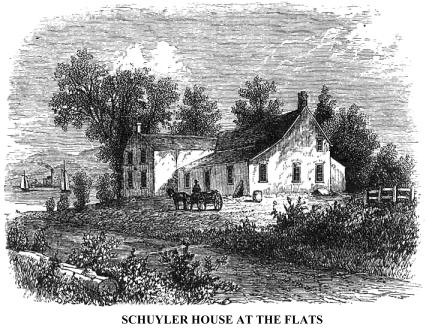 death,
his son Philip, the well-beloved of the Mohawks, who married his sweet cousin
Katrina--the "Aunt Schuyler" immortalized by Mrs. Grant, of Laggan,
in her charming pictures of "Albany Society a Hundred Years Ago"--resided
there, and with ample resources dispensed hospitality with a bounteous hand.
And yet this is not the identical house in which the mayor lived, and his
son Philip entertained friends and strangers, but the one built upon its ruins,
in the same style, the summer days of which are so charmingly portrayed by
Mrs. Grant. The old one was consumed by fire in the summer of 1759, when Philip
had been dead eighteen months, and "Aunt Schuyler," his widow, whose
waist he spanned with his hands when they were married forty years before,
had grown to such enormous dimensions, that a chair was made for her special
use. In that chair she was seated, under the cherry-trees in the lane, one
hot day in August, when the eminent Colonel John Bradstreet, riding up, gave
her the first intimation that her house was on fire. With calmness she kept
her seat, and gave directions to her servants and neighbours how to check
the flames, and to save her most valued articles. Before evening the blackened
brick walls were all that were left of that pleasant mansion. Aunt Schuyler
had a larger house in Albany, but she took shelter with her husband's deaf
brother Peter, who lived upon the hills near by.
death,
his son Philip, the well-beloved of the Mohawks, who married his sweet cousin
Katrina--the "Aunt Schuyler" immortalized by Mrs. Grant, of Laggan,
in her charming pictures of "Albany Society a Hundred Years Ago"--resided
there, and with ample resources dispensed hospitality with a bounteous hand.
And yet this is not the identical house in which the mayor lived, and his
son Philip entertained friends and strangers, but the one built upon its ruins,
in the same style, the summer days of which are so charmingly portrayed by
Mrs. Grant. The old one was consumed by fire in the summer of 1759, when Philip
had been dead eighteen months, and "Aunt Schuyler," his widow, whose
waist he spanned with his hands when they were married forty years before,
had grown to such enormous dimensions, that a chair was made for her special
use. In that chair she was seated, under the cherry-trees in the lane, one
hot day in August, when the eminent Colonel John Bradstreet, riding up, gave
her the first intimation that her house was on fire. With calmness she kept
her seat, and gave directions to her servants and neighbours how to check
the flames, and to save her most valued articles. Before evening the blackened
brick walls were all that were left of that pleasant mansion. Aunt Schuyler
had a larger house in Albany, but she took shelter with her husband's deaf
brother Peter, who lived upon the hills near by.
Intelligence of the disaster brought the people from all quarters. They testified their love for "Aunt Schuyler" by offering their services. In a few days materials for a new house were collected. Colonel Bradstreet sent up some of the king's troops then stationed in Albany to assist in building, and the part of the house seen on the right in the picture, was completed for use before the winter set in. Over the yawning cellars of the late mansion a broad wooden bridge was built, furnished with seats like a portico. "This," says Mrs. Grant, "with the high walls of the ancient house, which were a kind of screen before the new one, gave the whole the appearance of an ancient ruin."* Aunt Schuyler removed to her house in Albany, and leased the homestead; and, a few years later, the present house was built. In it a part of the old walls may be seen. It was owned when I visited it by Stephen R. Schuyler, Esq., a descendant of the mayor. His brother, John C. Schuyler, living upon the gentle hills near by, possessed a finely-executed portrait of that earliest chief magistrate of the city of Albany.
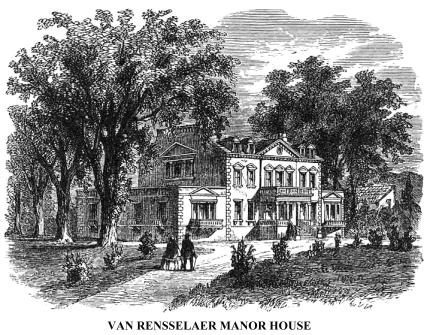 As
we approach Albany from the Flats, and reach the boundaries of "the Colonie,"
+the river shores are seen covered with huge piles of lumber, and lined with
vessels of almost every kind. The ear catches the distant hum of a large town
and the jangle of steamboat bells, while the city itself, built upon hills
and slopes, is more than half concealed by the lofty trees which surround
the manor house of the Van Rensselaer family in the northern part of the city.
This is one of the most attractive town residences in the State. The mansion,
erected in 1765, and recently somewhat modified in external appearance, stands
within a park of many acres, beautified by the hand of taste. It is adorned
with flowers and shrubbery, and its pleasant walks are shaded by grand old
trees, some of which were, doubtless, planted or were forest saplings, two
hundred years or more ago, when the first Patroon's mansion, with its reed-covered
roof, was erected there. Through the grounds flows Mill Creek, a clear stream
that comes down from the hills on the west, through the once sweet vale of
Tivoli, where, until the construction of a railway effaced it, the music of
a romantic cascade--the Falls of Tivoli--was heard.
As
we approach Albany from the Flats, and reach the boundaries of "the Colonie,"
+the river shores are seen covered with huge piles of lumber, and lined with
vessels of almost every kind. The ear catches the distant hum of a large town
and the jangle of steamboat bells, while the city itself, built upon hills
and slopes, is more than half concealed by the lofty trees which surround
the manor house of the Van Rensselaer family in the northern part of the city.
This is one of the most attractive town residences in the State. The mansion,
erected in 1765, and recently somewhat modified in external appearance, stands
within a park of many acres, beautified by the hand of taste. It is adorned
with flowers and shrubbery, and its pleasant walks are shaded by grand old
trees, some of which were, doubtless, planted or were forest saplings, two
hundred years or more ago, when the first Patroon's mansion, with its reed-covered
roof, was erected there. Through the grounds flows Mill Creek, a clear stream
that comes down from the hills on the west, through the once sweet vale of
Tivoli, where, until the construction of a railway effaced it, the music of
a romantic cascade--the Falls of Tivoli--was heard.
* "Memoirs of an American Lays," by
Mrs. Grant, of Laggan.
+ So named because it was the seat of the ancient colony of Rensselawerwyck.
The reader may inquire why the proprietor of this estate was called the Patroon, and invested with manorial title and privileges. History furnishes an answer in this wise:--The Dutch West India Company, having made all proper arrangements for colonizing New Netherlands, as New York was then called, passed a charter of privileges and exemptions in 1629, for the encouragement of Patroons, or patrons, to make settlements. It was provided that every Patroon, to whom privileges and exemptions should be granted, should, within four years after the establishment of a colony, have there, as permanent residents, at least fifty persons over fifteen years of age, one-fourth of whom should be located within the first year. Such privileges were granted to Killian Van Rensselaer, a pearl merchant of Amsterdam, and one of the directors of the West India Company, and by his direction the commissary and under commissary of Fort Orange, around whose site the city of Albany now stands, purchased of the Indians a tract of land in that vicinity. Another district was afterwards purchased, and Killian Van Rensselaer and three others became the proprietors of a tract of land, twenty-four miles long, upon each side of the Hudson, and forty-eight miles broad, containing over 700,000 acres of land, and comprising the present counties of Albany, Rensselaer, and a part of Columbia. Van Rensselaer held two shares, and the others one share each. They were his equals in privileges and exemptions, except in the title of Patroon, which, with all the feudal honours, was vested in him alone, the partners binding themselves to do fealty and homage for the fief on his demise, in the name and on behalf of his son and heirs. The manor did not become the sole property of the Van Rensselaer family until 1685.
The Patroon was invested with power to administer civil and criminal justice, in person or by deputy, within his domain, and, to some extent, he was a sort of autocrat. These powers were abolished when the English took possession of the province in 1664, and with it fell many of the special privileges, but, by the English law of primogeniture, that princely domain, farmed out to many tenants, remained in the family until the Revolution in 1775, and the title of Patroon was held by the late General Stephen Van Rensselaer, until his death, early in 1840, when it expired. A great portion of the manor has passed out of the hands of the Van Rensselaer family.
Copyright © 1998, -- 2004. Berry Enterprises. All rights reserved. All items on the site are copyrighted. While we welcome you to use the information provided on this web site by copying it, or downloading it; this information is copyrighted and not to be reproduced for distribution, sale, or profit.